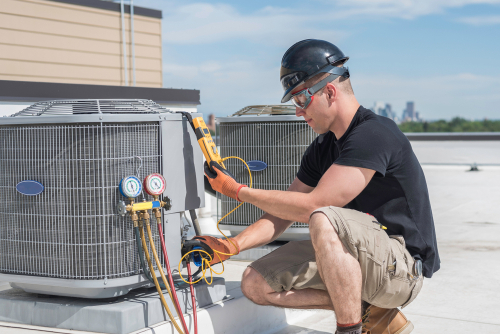It’s summertime, and many facilities professionals are hard at work on new building projects and major building renovations. There are several types of commercial heating, ventilation, and air conditioning (HVAC) systems to consider when a new system must be installed.

The National Institute of Building Sciences advises businesses to consider energy efficiency, occupant comfort, and improved indoor environmental quality, no matter what system they choose.
Facilities managers need to work with businesses to determine the type of HVAC system that needs to be installed.
Based on the opinions of several HVAC professionals, here are the most popular types of commercial HVAC systems:
1. Single-Split Systems
These typically include an air conditioner, a furnace, an evaporator coil, and a refrigerant and can be controlled using a thermostat. They heat or cool air and circulate it through ducts.
- Designed for small commercial spaces, such as individual offices, shops, and restaurants.
- Cheaper than a central system.
- An outdoor unit is paired with an indoor unit, so a lot of space is required.
2. Multi-Split Systems
These types of systems work similarly to single-split systems but include multiple units that work together. This saves money and energy because they utilize heat pumps that transfer heat from warm to cool areas, and small adjustments can automatically be made by the system.
- Designed for midsize commercial properties such as office suites, doctors’ offices, restaurants, and retail outlets.
- These units take up less space outside but require more ductwork inside.
- Units can be mounted to walls and ceilings, and air curtains can be installed over entrances.
3. Variable Air Volume (VAV) Systems
VAV systems supply air at a variable temperature and airflow rate. They can meet the varying heating and cooling needs of different commercial building zones and are designed for large commercial buildings.
According to the Pacific Northwest National Laboratory, the most common types of VAV systems include:
- Single duct terminal VAV box—These are the most simple and can be cooling only or with reheating.
- Fan-powered terminal VAV box—This type of system has a fan to pull warmer air into the zone and displace required reheat energy.
- Dual-ducted terminal VAV box—This system uses two ducts in the unit, one hot (or neutral) and one cold for space conditioning.
- Induction terminal VAV box—These pull warmer air into the zone and displace required reheat energy.
4. Variable Refrigerant Flow (VRF) Systems
VRF systems are a newer HVAC technology than VAV and can provide heating and cooling to a building using a refrigerant. They operate similarly to a ductless mini-split system, using variable motor speeds to control individual zones, each of which can have unique temperature control.
- Designed for facilities like large office buildings and hotels
- Have greater temperature control for individual zones like separate offices or conference rooms
- High energy efficiency
Types
- Air-cooled—Uses ambient air for heat rejection and absorption
- Water-cooled—Uses water for heat rejection and absorption
5. District Cooling Systems
According to the International District Energy Association, an insulated underground piping network delivers chilled water to buildings that then goes through a heat exchanger, absorbs heat from the building space, and recirculates back to the central plant. This is an efficient way to provide cooling to a number of buildings.
- Great solution for industrial and commercial buildings, as well as educational and hospital campuses and dense urban cities; and
- Reduces energy consumption through higher energy utilization.
The size of your facility is a huge factor when deciding whether to install a single-split system, a multi-split system, a VAV system, a VRF system, or a district cooling system.
